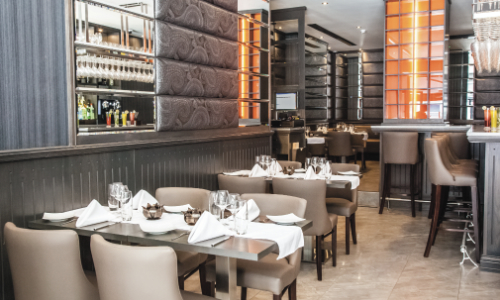Review: Lotus

The last five years have seen every restaurant in the country renounce their tablecloths. They’ve ripped the plaster off the walls to expose the jagged, crumbling brickwork beneath, because brickwork is real and plaster is a bourgeois pretension that is unbefitting of the foodie revolution. The furniture of the future will be mismatched, the paintwork artfully peeling. And you can stick your imperialist crockery where the sun don’t shine: we’ll eat from planks of wood we’ve prised from the very ground.
Every restaurant, that is, apart from the Indian ones, which have been hurtling at breakneck speed in the opposite direction, rolling out the beige carpets and gilt picture frames, calling in the sommeliers and generally being fabulous. There’s Trishna and Zaika and Cinnamon Soho and Chutney Mary and, of course, Gymkhana, restaurant of the year, golden child of the Indian dining scene. All of a sudden Indian food is vital and trendy, as exciting as any cuisine in the world. My-oh-my, what a time to be the proprietor of a high-end curry house.
None of this has escaped the attention of Bhaskar Banerjee, the chef-patron of the new Lotus restaurant in Charing Cross. The first thing you see on the Lotus website is the garbled message “An Epicurean Traditional Indian Gourmet Fine Indian Dining London”, which is quickly followed by the more legible “Fine Dining in the Heart of London”. This makes me happy, because fine dining and Indian food are two of the most wonderful things in this wonderful world of ours. But after eating there, I can’t help feeling I’ve been sold a pup.
It’s partly the dining room, which is clinical and sharp, with no nods whatsoever to the rich and varied culture from which the food originates. No paintings adorn the walls. Every surface is grey or mirrored, leaving you to gaze sadly at your own reflection. It strives for minimalist elegance but falls far short. The beady eyes of half a dozen CCTV cameras glare ominously down at you, making you wonder what they are so worried about people stealing (silverware doesn’t get you much down at Deptford Market).
But it’s more than that – the food, while far from bad, is straining to be more than it is. Golgappa – hollow balls of deep-fried bread – filled with corn looked pretty but lacked punch. The prawn, duck egg and green lentil wrap was nicely cooked but meek. The lobster tail and queenie malai curry was well presented – and wonderfully meaty – but too delicate, too hesitant. The flavours are there but they’re quiet and well behaved they should be vivid and arresting.
The best dishes were the simplest: 12-hour cooked black lentils in a rich, ghee-heavy sauce; a sturdy tube of minced duck seekh kebab with an orange date dip; a bowl of cumin and green pea rice that wouldn’t be out of place in the best Indian restaurants in the city.
Desserts were a microcosm of the rest of the meal, encapsulating both Lotus’s achievements and its failings. Mango shrikhand (a creamy, yoghurt-based dish) is the ideal thing to eat after a curry – light enough that you can stand up afterwards but with enough flavour that it isn’t insipid by comparison. It’s a good, honest, well made dish – the kind pudding you wouldn’t mind lending a tenner. But Lotus dresses it up with a little circle of half-grapes and melon balls. That’s not fine dining – it’s window dressing. And the almond kheer (rice pudding) with delicious parcels of sweet beetroot halva didn’t need the sprinkling of “gold dust”, which made it look like someone had spilt glitter all over it (apparently it’s a nod to the days when Indian soldiers would be fed gold-leaf prior to battle to improve their virility).
Lotus is a perfectly decent restaurant, serving more interesting fare than a bog-standard, beer-sponge curry house. But by pitching itself against the big-boys of sub-continental dining – the Gymkhana’s of the world – it’s setting itself up to fail. The food is fine, but it’s not fine dining.
First published in City A.M.

